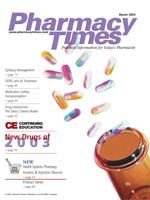Publication
Article
Pharmacy Times
Case Studies
Author(s):
Case One
JS, a 33-year-old man with a history of tonic-clonic seizures, presents to the local walk-in clinic with a chief complaint of heartburn. Despite having these symptoms for a few months and attempting to control them with antacids, he could no longer tolerate the pain and did not want to wait until the next morning to call his primary care physician.
JS' medication therapy also has included phenytoin 300 mg 2 times daily. He is unable to remember what medication he is taking and therefore does not tell the physician at the walk-in clinic.
Based on JS' signs and symptoms, the physician diagnoses JS with gastroesophageal reflux disease. He prescribes famotidine 40 mg 2 times daily and omeprazole 20 mg 2 times daily. He also recommends that JS follow up with his own physician to ensure that these medications will not interact with his seizure medication.
Because his reflux improved, JS decided to not call his physician. A week later, JS' wife calls the primary care doctor's office. She reports that JS has become increasingly lethargic, confused, and dizzy over the past 3 days.Today, JS is also complaining of visual disturbances. The doctor requests that JS' wife bring him to the office immediately.
Upon arrival at the office, JS needs assistance walking to the examination room. He can barely answer the physician's questions. On examination, nystagmus on lateral gaze is present. Because JS' wife reports that it has been 12 hours since his last phenytoin dose, a phenytoin level is drawn. It is reported as 36 mg/L.
Given the fact that JS' wife denies any changes in his phenytoin dose, the physician inquires about any other medication changes that may have caused this increase in the phenytoin level.
The wife produces the prescription bottles for famotidine and omeprazole. The physician points to 1 of the bottles and tells the wife that JS is to no longer take that medication because it interacts with the phenytoin.
JS receives a phone call 10 days later informing him that his latest phenytoin level is normal and that he should restart his phenytoin 300 mg 2 times daily. JS admits to the physician that he had stopped the famotidine and omeprazole because he was so upset about the interaction. Now he cannot remember which medication would interact with the phenytoin and which would not.
Which medication will interact with the phenytoin?
Case Two
PM, a 35-year-old woman, calls the pharmacy in a panic. She adamantly demands to speak with the pharmacist. When the pharmacist picks up the phone, PM is so upset that the pharmacist is barely able to understand her.
PM finally calms down enough to explain that she has just removed a tick from her 5-year-old son's leg. She had taken him outside to play on his grandparent's farm in Connecticut. When they finished playing, she noticed the tick. She is positive that the tick was not on his leg when they went outside.
She explains that she used a pair of fine-tipped tweezers to grasp the tick by the head as close as possible to the skin. She then slowly but firmly pulled the tick straight out, without twisting or jerking the tick. Because she had read in a women's magazine that the use of matches or oil may increase the risk of transmitting Lyme disease, she did not use these.
Although she removed the tick, she is concerned that the tick infected her son with Lyme disease since she is in an epidemic area. What should the pharmacist tell her about the likelihood that the tick transferred the disease to her son?
Click Here For The Answer ----------->
[-]
Case ONE
Omeprazole inhibits the hepatic enzymes involved in phenytoin?s metabolism. Because the phenytoin levels returned to normal after the omeprazole was discontinued, even after the famotidine and phenytoin were restarted, the interaction is confirmed.
Case TWO
Typically the tick must be attached to the skin for 36 to 48 hours before it can transmit Lyme disease. Because the tick was attached for only a short time, the likelihood is low. PM should watch the site of the bite for the next 30 days to monitor for a red rash. If a bull?s-eye rash develops, she should notify a physician immediately.
toggle(getObject('exp1048685570_link'), 'exp1048685570');







